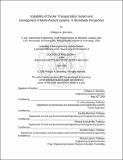Scalability of the air transportation system and development of multi-airport systems : a worldwide perspective
Author(s)
Bonnefoy, Philippe A
DownloadFull printable version (9.829Mb)
Other Contributors
Massachusetts Institute of Technology. Engineering Systems Division.
Advisor
R. John Hansman.
Terms of use
Metadata
Show full item recordAbstract
With the growing demand for air transportation and the limited ability to increase capacity at some key points in the air transportation system, there are concerns that in the future the system will not scale to meet demand. This situation will result in the generation and the propagation of delays throughout the system, impacting passengers' quality of travel and more broadly the economy. This thesis proposes the investigation of the mechanisms by which the air transportation system has scaled to meet demand in the past and is expected to do so in the future using a multi-level engineering systems approach.The air transportation system was first analyzed at the U.S. national level using network abstractions. In order to investigate limits in scaling of the U.S. air transportation network, theories of scale-free and scalable networks were used. It was found that the U.S. air transportation network was not scale-free due to capacity constraints at major airports, also preventing it from being scalable. However, the construction and analysis of a new network for which sets of two or more significant airports that serve passenger traffic in a metropolitan region (i.e. multi-airport systems) were aggregated into single nodes showed that it was scale-free and scalable. These results were also supported by a time series analysis of airport and multi-airport system growth. These analyses demonstrated the importance of regional level scaling mechanisms (i.e. development of multi-airport systems) in the ability of the air transportation system to adapt and scale to meet demand. (cont.) Given the importance of multi-airport systems, an in-depth multiple-case study analysis of 59 multi-airport systems worldwide was performed. This analysis was used to develop a feedback model that captures the fundamental processes that govern the evolution of multi-airport systems. Multi-airport systems were found to evolve according to two fundamental mechanisms: (1) the construction of new airports and (2) the emergence of secondary airports through the use of existing non-utilized airports. Several differences and similarities in the occurrence of these dynamics were identified across world regions. It was found that in the United States and Europe, the construction of new large airports occurred prior to or during World War II and to a minor extent during the 1960s and 1970s. More recently, significant limitations to the development of new airports (e.g. opposition from local communities) and changes in the airline industry (e.g. emergence and growth of low-cost carriers) led multi-airport systems in the United States and Europe to evolve through the emergence of secondary airports. In the Asia-Pacific region, multi-airport systems have predominantly evolved through the construction of new airports, due to fewer available airports, high projections of demand and weaker opposition to the construction of airports.The analyses and insights from this thesis were also used to analyze and better understand the evolution of future multi-airport systems and provide recommendations for infrastructure management policies and multi-airport system development strategies. (cont.) In the United States and in Europe, there is the need to protect non-utilized exiting airport infrastructure (both civil and military airports) that can later be used to accommodate demand through the emergence of secondary airports. In parts of Asia where the existing under-utilized airport infrastructure is weak and where projections of high volume of demand -with high uncertainty- are high, there is the need to apply a dynamic approach to develop multi-airport systems. This approach includes actions such as reserving land area for future airport development and keeping original airports open since this option has proven to be useful and successful in the other regions of the world (i.e. United States and Europe). In some parts of Asia, such as India, where the military airport infrastructure is more developed than in other parts, there is also the need, as in the United States and Europe, to protect these airports since they may become future secondary airports following the airport status conversion dynamics that were observed in Europe.
Description
Thesis (Ph. D.)--Massachusetts Institute of Technology, Engineering Systems Division, 2008. This electronic version was submitted by the student author. The certified thesis is available in the Institute Archives and Special Collections. Includes bibliographical references (p. 227-235).
Date issued
2008Department
Massachusetts Institute of Technology. Engineering Systems DivisionPublisher
Massachusetts Institute of Technology
Keywords
Engineering Systems Division.